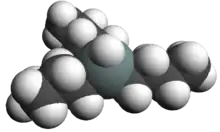Imposex
Imposex is a disorder in sea snails caused by the toxic effects of certain marine pollutants. These pollutants cause female sea snails (marine gastropod molluscs) to develop male sex organs such as a penis and a vas deferens.
Imposex inducing substances

It was believed that the only inducer of imposex was tributyltin (TBT),[1] which can be active in extremely low concentrations, but recent studies reported other substances as inducers, such as triphenyltin[2] and ethanol.[3] Tributyltin is an anti-fouling agent for boats which affects females of the species Nucella lapillus (dog whelk), Voluta ebraea (the Hebrew volute),[4] Olivancillaria vesica,[5] Stramonita haemastoma[6] (red-mouthed rock shell) and more than 200 other marine gastropods.
Abnormalities
In the dog whelk, the growth of a penis in imposex females gradually blocks the oviduct, although ovule production continues. An imposex female dog whelk passes through several stages of penis growth before it becomes unable to maintain a constant production of ovules. Later stages of imposex lead to sterility and the premature death of the females of reproductive age, which can adversely affect the entire population.[4]
Biomonitoring
The imposex stages of female dog whelks and other molluscs (including Nucella lima) are used in the United Kingdom and worldwide to monitor levels of tributyltin. The RPSI (Relative Penis Size Index) of females to males, and the VDSI (Vas Deferens Sequence Index) are used to monitor levels of tributyltin in marine environments.
On September 29, 2007, the Halifax, Nova Scotia, newspaper The Chronicle Herald featured a story on female dog whelks on the shores of Halifax Harbour and other parts of Nova Scotia, where they live on the beach in the intertidal zone. The report stated that female dog whelks still grow penises even after a ban on tributyltin.[7]
See also
References
- Ruiz JM, Quintela M, Barreiro R (1998) Tributyltin and imposex: no uncertainty shown. Mar Ecol Prog Ser 170: 293–294
- Horiguchi, T.; et al. (1995). "Imposex in Japanese gastropods (Neogastropoda and Mesogastropoda): effects of tributyltin and triphenyltin from anti-fouling paints". Marine Pollution Bulletin. Oxford. 31 (4–12): 402–405. doi:10.1016/0025-326X(95)00133-8.
- Davies, I. M.; et al. (1997). "Sublethal effects of tributyltin oxide on thedog whelk Nucella lapillus". Marine Ecology Progress Series. 158: 191–204. doi:10.3354/meps158191.
- Castro, Í. B.; et al. (2008). "Imposex in endemic volutid from Northeast Brazil (Mollusca: Gastropoda)" (PDF). Brazilian Archives of Biology and Technology. Brazil. 51 (5): 1065–1069. doi:10.1590/s1516-89132008000500024. ISSN 1516-8913.
- Caetano, C. H. S.; Absalão, R. S. (2002). "Imposex in Olivancillaria vesica vesica (Gmelin) (Gastropoda, Olividae) trom a Southeastern Brazilian sandy beach" (PDF). Revista Brasileira de Zoologia. Brazil: Sociedade Brasileira de Zoologia. 19 (2): 215–218. doi:10.1590/S0101-81752002000600022. ISSN 0101-8175.
- Fernandez, M. A.; et al. (2002). "Occurrence of imposex in Thais haemastoma: possible evidence of environmental contamination derived from organotin compounds in Rio de Janeiro and Fortaleza, Brazil" (PDF). Cadernos de Saúde Pública. Rio de Janeiro, Brazil: Fundação Oswaldo Cruz. 18 (2): 463–476. doi:10.1590/S0102-311X2002000200011. ISSN 0102-311X. PMID 11923888. Archived from the original (PDF) on 2011-09-28.
- "Tiny Snail, Big Problem" The Chronicle Herald, Halifax, NS, Canada. Sat, September 29th, 2007. http://www.thechronicleherald.ca/Science/914854.html%5B%5D
- Gibbs, P.E., Bryan, G.W. (1986). Reproductive failure in populations of the dog-whelk Nucella lapillus, caused by imposex induced by tributyltin from antifouling paints. J. Mar. Biol. Assoc. U. K. 66: 767–777.
- "Occurrence of Imposex." Natural Resource Management. 2006.
- Wirzinger, G., Vogt, C., Bachmann, J., Hasenbank, M., Liers, C., Stark, C., Ziebard, S. & Oehlmann, J. (2007). Imposex of the netted whelk Nassarius reticulatus (Prosobranchia) in Brittany along a transect from a point source. Cah. Biol. Mar. 48(1): 85–94.